
By Kate Bussmann
Photos by Jessica Antola
May 2024
Merchants have been traversing the Silk Road across Central Asia for over 1,500 years—but it’s still full of surprises today, as travel photographer Jessica Antola discovered
A few years ago, Jessica Antola realized she’d visited 100 countries. A passionate travel photographer obsessed with history and geography, she had explored the Middle East, the African continent, spent years in Europe and visited China, with her photographs winning awards and appearing in exhibitions, books and publications from the New York Times to Condé Nast Traveler. But there was a missing piece to the puzzle. One less explored by Western travelers, but that had helped to shape the West: the Silk Road—and, more specifically, those Central Asian countries known as “the Stans.”
“When you say ‘Central Asia’, a lot of people have no idea what you mean,” Antola says. “After I came back, for instance, somebody said to me, ‘Oh yes, I was just in Bangkok’. People don’t know how important the Stans—Kazakhstan, Tajikistan, Kyrgyzstan, Uzbekistan, and Turkmenistan—are to the history of the world. They were the birthplace of so many things: religion, ideas, languages. When Europe was a muddy backwater, they were basically the center of the universe.”
A boy riding a donkey tries to keep up with Antola's car
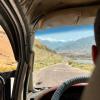
Entering the Pamirs. “Afghanistan was to our right, over the water,” says Antola. “The only thing that sometimes didn’t feel safe was the roads, but as our guide said, 15 years ago, there were no roads here, only footpaths.”
For more than 1,500 years, Central Asia, thanks to its crucial position on the ancient Silk Road, was exactly that. Merchants and explorers like Marco Polo traveled this network of routes that extended 4,000 miles, bringing horses, gold and silver east to China, and gunpowder and silk west to Europe. Along the way, a network of well-organized, buzzy rest stops known as caravanserai sprang up along the way—places to eat, sleep, wash and pray.
“I wanted to see the ancient caravanserai, but I was also thinking, how am I going to document something that’s basically in ruins?” says Antola. “And so for me, what came to forefront were the markets and the people, because I think they’re the strongest representation of what the Silk Road represented.”

A man selling handicrafts at the ruins of the Qah-Qaha Fortress, aka Khakha Fortress. “This is in the Wakhan Corridor, which connects Tajikistan, Afghanistan, Pakistan, and China. Marco Polo is said to have walked this route.”

Shymkent, southern Kazakhstan. “I love photographing people just living their lives. I had just come from Tajikistan, which felt so culturally different, and technologically less advanced, so I was thinking how liveable and wonderful this city is.”

Nuts and dried fruit at Zelyony Bazaar, aka Green Bazaar, in Almaty, southern Kazakhstan. “This market had everything from horse meat to Korean food. I kept thinking: Back in the Silk Road days, what must the bazaars have been like?”

Jety-Oguz canyon in Kyrgyzstan. “This is a famous, beautiful red-rock area. There’s still a sense of the semi-nomadic lifestyle here: In winter, they move the cattle and the yurt back to the village.”

Osh Bazaar in Bishkek, the capital of Kyrgyzstan. “All of these former Soviet cities have grand boulevards, parks—and a great market.”
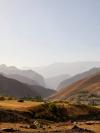
Along the Pamir Highway outside of Qal’ai Khumb, Tajikistan. “Many trips offered online do a day in Tajikistan, a bit longer in Uzbekistan. What I loved about spending longer was that I could go deep.”

A man selling handicrafts at the ruins of the Qah-Qaha Fortress, aka Khakha Fortress. “This is in the Wakhan Corridor, which connects Tajikistan, Afghanistan, Pakistan, and China. Marco Polo is said to have walked this route.”

Shymkent, southern Kazakhstan. “I love photographing people just living their lives. I had just come from Tajikistan, which felt so culturally different, and technologically less advanced, so I was thinking how liveable and wonderful this city is.”

Nuts and dried fruit at Zelyony Bazaar, aka Green Bazaar, in Almaty, southern Kazakhstan. “This market had everything from horse meat to Korean food. I kept thinking: Back in the Silk Road days, what must the bazaars have been like?”

Jety-Oguz canyon in Kyrgyzstan. “This is a famous, beautiful red-rock area. There’s still a sense of the semi-nomadic lifestyle here: In winter, they move the cattle and the yurt back to the village.”

Osh Bazaar in Bishkek, the capital of Kyrgyzstan. “All of these former Soviet cities have grand boulevards, parks—and a great market.”

Along the Pamir Highway outside of Qal’ai Khumb, Tajikistan. “Many trips offered online do a day in Tajikistan, a bit longer in Uzbekistan. What I loved about spending longer was that I could go deep.”

A man selling handicrafts at the ruins of the Qah-Qaha Fortress, aka Khakha Fortress. “This is in the Wakhan Corridor, which connects Tajikistan, Afghanistan, Pakistan, and China. Marco Polo is said to have walked this route.”












While today it is easier than ever to travel to this part of the world, with plenty of well-organized guided tours available to book, Antola was keen to go even further off the beaten path. She wanted to see the Pamirs, a rugged mountain range crossing from Tajikistan into Afghanistan—and although her trip skirted that border, as she was with guides on a well-planned route, she never went anywhere that was unsafe to travel.
And when she arrived for her 24-day trip last August, she found beautiful bazaars, selling goods from around the world, from locally popular horsemeat and dried yogurt balls, to macadamia nuts from Australia and cold specialities from Korea. She traveled between wildly disparate locations, from the modern, wealthy cities of Kazakhstan to remote rural regions of Tajikistan; from humble yurts to grand Soviet architecture, to painted houses that looked “almost like gingerbread.”

Antola holding an eagle in eastern Kyrgyzstan
And everywhere, she found warm welcomes. In a small village in eastern Kyrgyzstan, on the southern shore of the lake Issyk-kul, she joined a trip to visit an eagle hunter named Nursultan Burkutchu. “When we arrived at his house, his mother had prepared us lunch, and we ate together,” she recalls.
“Afterwards, they took us out and his assistant took the bird and rode off on a horse to a distant hill. Over and over, the hunter held up meat, and the eagle would swoop down and chomp it up. It was fascinating to watch. Hunting with eagles is something his family has been doing for centuries. It’s part of their heritage.”
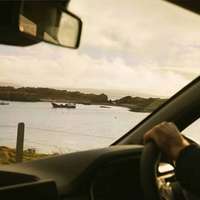
Free-wheeling on the Wild Atlantic Way
Ireland’s coastal route takes in 1,600 miles of dramatic cliffs, cosy pubs and sacred sites
One photo from the trip, not taken by Antola, shows her holding the eagle. “We all held him,” she says. “He was so heavy, just massive—the wingspan was probably nine feet.”
While she has traveled much of the world—and this year is set to bring yet more trips, from the Aeolian Islands to Zanzibar—her journey along the Silk Road isn’t done yet. “I want to explore the cities of Khiva, Bukhara and Samarkand, and I’m curious about Turkmenistan,” she says. “And I hear the spring is also beautiful there—I’d love to see the wildflowers…”

At Dushanbe Bazaar. “Our guide was a newlywed, and tradition dictates that for the first 40 days of marriage, you dress to the hilt—we’re talking tiaras, nails and makeup. I loved these embellished plexiglass heels.”

Dressed for the bazaar, Panjakent, Tajikistan. “I was so in awe of the women at the bazaars. The market is the center of everything, which is something I’ve seen the world over: the amazing way the women in particular present themselves.”

Bread at the bazaar in Khorog, Tajikistan. “With every meal, there’s homemade yogurt, fresh tomatoes, dill, cucumbers, and bread—bread is very important in Tajikistan.”

A bread maker in Dushanbe, Tajikistan. “Every bread maker has their own stamp. Infinite ornamentation is part of the culture—you see it in the architecture, the fabrics, everywhere.”

Produce for sale along the road in the countryside outside Dushanbe. “It’s the most perfect place: rolling hills, winding creeks, the farmland, and beautiful houses.”

A man at a watermelon stand on the road between Dushanbe and Qal’ai Khumb. “I was there in summer, and everywhere you go, people are selling fruit—from stands, the trunks of cars…”
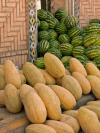
Istaravshan Bazaar. “In summer, you see lots and lots of melons in the markets and alongside the road. I’d love to go back in the wintertime to see how it’s different.”
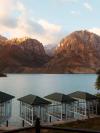
Iskandarkul, or Alexander the Great Lake, Tajikistan. “These dining rooms were part of the guest house where I stayed. I didn’t see anything like them elsewhere.”

Dried yogurt balls for sale on the roadside on the way to the Pamir Mountains. “I tried one—trying new things is part of travel, right? But they’re not to my taste!”

At Dushanbe Bazaar. “Our guide was a newlywed, and tradition dictates that for the first 40 days of marriage, you dress to the hilt—we’re talking tiaras, nails and makeup. I loved these embellished plexiglass heels.”

Dressed for the bazaar, Panjakent, Tajikistan. “I was so in awe of the women at the bazaars. The market is the center of everything, which is something I’ve seen the world over: the amazing way the women in particular present themselves.”

Bread at the bazaar in Khorog, Tajikistan. “With every meal, there’s homemade yogurt, fresh tomatoes, dill, cucumbers, and bread—bread is very important in Tajikistan.”

A bread maker in Dushanbe, Tajikistan. “Every bread maker has their own stamp. Infinite ornamentation is part of the culture—you see it in the architecture, the fabrics, everywhere.”

Produce for sale along the road in the countryside outside Dushanbe. “It’s the most perfect place: rolling hills, winding creeks, the farmland, and beautiful houses.”

A man at a watermelon stand on the road between Dushanbe and Qal’ai Khumb. “I was there in summer, and everywhere you go, people are selling fruit—from stands, the trunks of cars…”

Istaravshan Bazaar. “In summer, you see lots and lots of melons in the markets and alongside the road. I’d love to go back in the wintertime to see how it’s different.”

Iskandarkul, or Alexander the Great Lake, Tajikistan. “These dining rooms were part of the guest house where I stayed. I didn’t see anything like them elsewhere.”

Dried yogurt balls for sale on the roadside on the way to the Pamir Mountains. “I tried one—trying new things is part of travel, right? But they’re not to my taste!”

At Dushanbe Bazaar. “Our guide was a newlywed, and tradition dictates that for the first 40 days of marriage, you dress to the hilt—we’re talking tiaras, nails and makeup. I loved these embellished plexiglass heels.”



























A journey into the past: Few people ever traveled the full 4,000-mile expanse of the Silk Road, from its easternmost point in Xi’an, China, as far as Istanbul, where Asia meets Europe. Merchants instead ferried goods between key stops along the way, where diverse cultures and religions bumped up against each other: The perfect recipe to create some of the world’s most fascinating destinations.

Kate Bussmann is an editor at Expedia Group, covering all aspects of culture and style. She has hosted live and online events, written and edited for titles including The Times, The Telegraph, InStyle, Glamour, and Marie Claire, and appeared on NPR, the BBC and Sky News. She has lived in London, New York and Naples, and one day plans to move to Paris.
